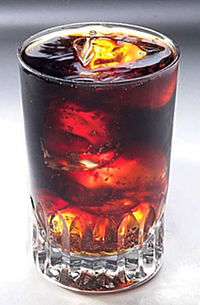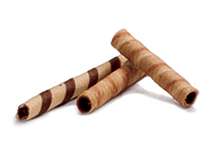Caramel color

Caramel color or caramel coloring is a water-soluble food coloring. It is made by heat treatment of carbohydrates, in general in the presence of acids, alkalis, or salts, in a process called caramelization. It is more fully oxidized than caramel candy, and has an odor of burnt sugar and a somewhat bitter taste. Its color ranges from pale yellow to amber to dark brown.
Caramel color is one of the oldest and most widely used food colorings, and is found in many commercially produced foods and beverages, including batters, beer, brown bread, buns, chocolate,[1] cookies, cough drops, spirits and liquor such as brandy, rum, and whisky,[2] chocolate-flavored confectionery and coatings, custards, decorations, fillings and toppings, potato chips,[3] dessert mixes, doughnuts, fish and shellfish spreads, frozen desserts, fruit preserves, glucose tablets, gravy, ice cream, pickles,[4] sauces and dressings, soft drinks (especially colas), sweets, vinegar, and more. Caramel color is widely approved for use in food globally but application and use level restrictions vary by country.[5]

Production
Caramel color is manufactured by heating carbohydrates, either alone or in the presence of acids, alkalis, and/or salts. Caramel color is produced from commercially available nutritive sweeteners consisting of fructose, dextrose (glucose), invert sugar, sucrose, malt syrup, molasses, starch hydrolysates and fractions thereof. The acids that may be used are sulfuric, sulfurous, phosphoric, acetic, and citric acids; the alkalis are ammonium, sodium, potassium, and calcium hydroxides; and the salts are ammonium, sodium, and potassium carbonate, bicarbonate, phosphate (including mono- and dibasic), sulfate, and bisulfite. Antifoaming agents, such as polyglycerol esters of fatty acids, may be used as processing aids during manufacture.[7] Its color ranges from pale-yellow to amber to dark-brown.
Caramel color molecules carry either a positive or a negative charge depending upon the reactants used in their manufacture. Problems such as precipitation, flocculation, or migration can be eliminated with the use of a properly charged caramel color for the intended application.
Classification
Internationally, the United Nations Joint Food and Agriculture Organization/World Health Organization Expert Committee on Food Additives (JECFA) recognizes four classes of caramel color, differing by the reactants used in their manufacture, each with its own INS and E number, listed in the table below.
| Class | INS No. | E Number | Description | Restrictions on preparation | Used in[8] |
|---|---|---|---|---|---|
| I | 150a | E150a | Plain caramel, caustic caramel, spirit caramel | No ammonium or sulfite compounds can be used | Whiskey and other high proof alcohols |
| II | 150b | E150b | Caustic sulfite caramel | In the presence of sulfite compounds but no ammonium compounds can be used | Cognac, sherry and some vinegars |
| III | 150c | E150c | Ammonia caramel, baker's caramel, confectioner's caramel, beer caramel | In the presence of ammonium compounds but no sulfite compounds can be used | Beer, sauces, and confectionery |
| IV | 150d | E150d | Sulfite ammonia caramel, acid-proof caramel, soft-drink caramel | In the presence of both sulfite and ammonium compounds | Acidic environments such as soft drinks |
Color

Color Intensity (Tinctorial Power) is defined as the absorbance of a 1 mg/mL (0.1%) solution (weight/volume) in water, measured using a 1 cm light path at a wavelength of 610 nanometers (or 560 nm for tinctorial power).[7] In this case, A stands for absorbance and TS stands for total solids.
The color tone of the caramel color is also important. This is defined by the Linner Hue Index, which is the measure of the color hue or red characteristics of the caramel color. It is a function of the absorbance of light of wavelengths 510 and 610 nm. In general, the higher the Tinctorial Power, K0.56, the lower the Hue Index and the lower the red tones.[9]
Various other indices are in use around the world and there are conversion factors between them.[10][11]
Additional function
Caramel color is a colloid. Though the primary function of caramel color is for coloration, it also serves additional functions. In soft drinks, it can function as an emulsifier[12] to help inhibit the formation of certain types of "floc" and its light protective quality can aid in preventing oxidation of the flavoring components in bottled beverages.[13]
Toxicology
Internationally, JECFA has set the Acceptable Daily Intake (ADI) of Class I caramel color as "not specified"; that of Class II as 0–160 mg/kg body weight; that of Class III as 0–200 mg/kg body weight; and that of Class IV as 0–200 mg/kg body weight.[14]
The United States Food and Drug Administration (FDA) classifies and regulates caramel color in Title 21 CFR § 73.85 as a generally recognized as safe (GRAS) color additive exempt from certification. Unless a food has a standard of identity, caramel color may be safely used in foods generally at levels consistent with "good manufacturing practice" (GMP).
In 2010, the International Programme on Chemical Safety (IPCS) concluded that commercially produced caramel color has the same toxicological properties as caramel produced by cooking or heating sucrose, except for those prepared using ammonium (Class III and IV). The IPCS has concluded that caramel color does not exhibit carcinogenicity or mutagenicity, based on its studies.[15] While the US FDA,[16] Canadian Health Products and Food Branch[17] and European Food Safety Authority (EFSA)[18] have found caramel color safe for use in food and beverages, California has listed a compound formed in the manufacture of Class III and IV caramel colors in the state's Proposition 65,[19] thus legally including it in the category of chemicals "known to the state to cause cancer or reproductive toxicity".
According to the Food Chemicals Codex, 4-Methylimidazole in caramel color is allowed up to 250 ppm on a color-adjusted basis, which means 250 ppm maximum for every 0.100 color absorbance of a 0.10% solution at 610 nm.[20]
Caramel color has excellent microbiological stability. Since it is manufactured under very high temperature, high acidity, high pressure, and high specific gravity, it is essentially sterile, as it will not support microbial growth unless in a dilute solution.
When reacted with sulfites, caramel color may retain traces of sulfite after processing. However, in finished food products, labeling is usually required only for sulfite levels above 10 ppm.
Food allergies
Caramel coloring may be derived from a variety of source products that are themselves common allergens, starch hydrolysates (from wheat), malt syrup (in general derived from barley), or lactose (from milk). As such, persons with known sensitivities or allergies to food products are advised to avoid foods including generic caramel coloring or first determine the source for the caramel coloring before consuming the food. North American and European manufacturers mostly use glucose derived from corn or wheat to produce caramel color, which is highly processed and is generally considered gluten-free.[21]
Notes
- Joint FAO/WHO Expert Committee on Food Additives (JECFA) specification for Caramel Colours
- U.S. Food and Drug Administration definition of Caramel, Code of Federal Regulations 21 CFR 73.85
- European Commission Directive 95/45/EC (26 July 1995) on food color purity
- International Programme on Chemical Safety INCHEM Database
References
- ↑ "Other Applications: Cocoa/Chocolate". Caramel Color Application Guide. Sethness. Retrieved 25 Nov 2013.
- ↑ Can you taste E150a in whisky?, Master of Malt Blog, 2011-03-18, retrieved 2016-09-30
- ↑ "Zapp's Potato Chips Ingredient Lists". Zapps, Inc. Retrieved 25 Nov 2013.
- ↑ "Sweet Pickle Chips". M.A. Gedney Co. Retrieved 25 Nov 2013.
- ↑ Food & Beverage Processing Regulatory Resources, DD Williamson, retrieved 2012-01-19
- ↑ "Soy Sauce". ddwcolor.com. DD Williamson. Retrieved 11 Jun 2015.
- 1 2 FCC 7 Monographs / Caramel / 165, FCC, retrieved 2011-11-07
- ↑ "Select the Appropriate Class of Caramel". Select Your Class. DD Williamson. Archived from the original on 2013-06-24. Retrieved 9 Apr 2013.
- ↑ Physical and Chemical Properties of Caramel Color, Sethness-Roquette Caramel Color, retrieved 2009-04-26
- ↑ EBC’s & Caramel Color, DD Williamson, retrieved 9 Apr 2013
- ↑ Grover, D. W. (1968), "The measurement and character of caramel colour", Journal of Food Technology, Institute of Food Science and Technology, 3 (4): 311–323, doi:10.1111/j.1365-2621.1968.tb01472.x, retrieved 2009-04-26
- ↑ US Caramel is used as an emulsifying agent in preparing an aqueous emulsion of a water-insoluble flavoring oil. The emulsion is utilized in preparing flavored beverage syrups and flavored beverages 3622343, Anwar, Mohammad H. & Marvin Calderon, "Emulsions of flavoring oils and process for making same", published 12 Dec 1963, issued 23 Nov 1971
- ↑ Kamuf, William; Nixon, Alexander R.; Parker, Owen D.; Barnum, G. Campbell, Jr. (March–April 2003). "Overview of Caramel Colors" (pdf). Cereal Foods World. American Association of Cereal Chemists, Inc. 48 (2): 64–69. Retrieved 9 Aug 2012.
- ↑ JECFA (2011), CARAMEL COLOURS (PDF), FAO
- ↑ CARAMEL COLOURS, IPCS, 2010-09-21, retrieved 2012-01-19
- ↑ Yukhananov, Anna (5 Mar 2012). "US regulators dispute finding of cancer-causing soda". Reuters. Washington: Reuters.com. Retrieved 29 Oct 2012.
- ↑ Lee, Barbara (15 Nov 2011), Letter from Director of Bureau of Chemical Safety (PDF), Health Canada, Health Products and Food Branch, archived from the original (PDF) on 2013-05-11
- ↑ Scientific Opinion on the re-evaluation of caramel colours (E 150 a,b,c,d) as food additives, European Food Safety Authority (EFSA), retrieved 2012-01-16
- ↑ Proposition 65, OEHHA, retrieved 2012-01-16
- ↑ "FCC Monographs: Caramel Color", Food Chemicals Codex (PDF) (8, S1 ed.), The United States Pharmacopeial Convention, 2012, pp. 202–208, ISBN 978-1-936424-06-1
- ↑ Case, Shelley (2008). Gluten-Free Diet: A Comprehensive Resource Guide (Revised-Expanded ed.). Case Nutrition Consulting, Inc. ISBN 978-1-897010-54-9.